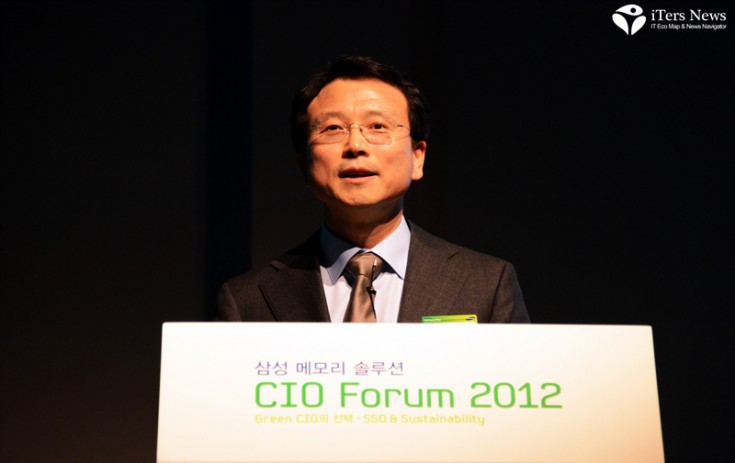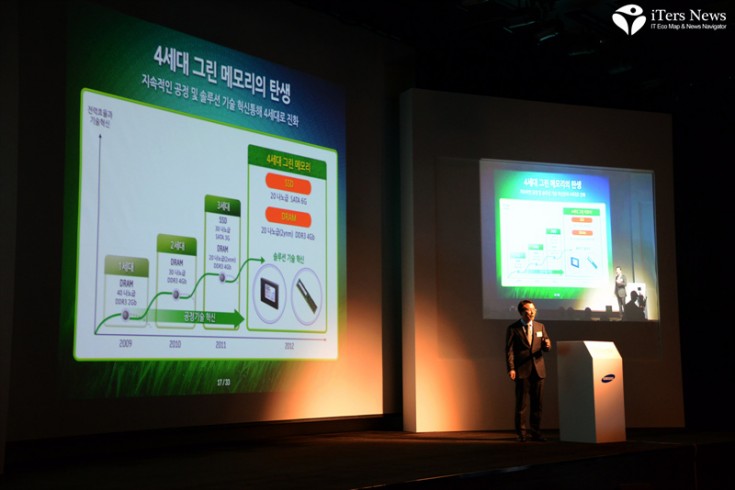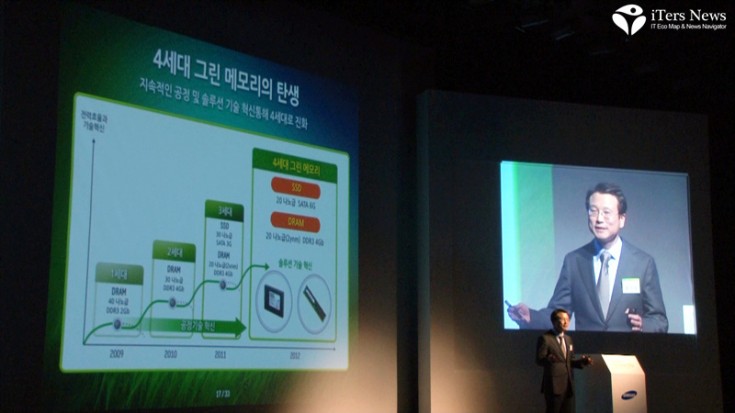Booming sales of more lucrative, energy-efficient ‘Green Memory’ solution to corporate datacenter server market help to take up slacks in the shipments to consumer PC market.
As Samsung sets to roll out a 4th generation of ‘Green Memory’ solutions, the world’s largest chipmaker plans to launch its ‘Green Memory’ marketing campaign even in the consumer PC market.
Samsung plans to churn out a 20nm 4Gb DDR3 DRAM, one of its 4th generation of ‘Green Memory’ solution, setting its sights on consumer PC markets.

Most of them are still struggling with their ramp-up from 40nm to 30nm design rule.
Combined with higher productivity per wafer, the premium green DDR3 DRAM chip would help generate more profits, making it less affected from downward spirals in prices. Consumers also can get great benefits. The power consumption of the 20nm 4Gb DDR3 DRAM chips cut back by 7% to 17%, compared with its 3rd generation 30nm counterpart, just consuming 18 watts.
Quantum leaps in power & performance
By replacing notebooks using 40nm-class 4GB DDR3 and HDDs with Samsung’s advanced 20nm-class 4GB DDR3 module paired with its latest 250-Gigabyte SSDs, the performance is comparable with newly launched notebooks and battery life is extended by approximately one hour, greatly raising user convenience and mobility
‘The term of ‘Green Memory’ solution was coined by Samsung as part of its premium high-end marketing strategy aimed at enterprise server and data center server market, featuring ultra-low power consumption.
What makes the 4th generation ‘Green Memory’ solution stand out from the previous generations is that they are not only power-thriftier, but also can help significantly boost system-level performance and processing speed.

Green Memory in consumer PC market
“Memory chips are no longer a simple data storage device, but are evolving into a complete solution with a controller circuitry and firmware to give add-on values. Unlike the previous generations that achieved innovations only in the manufacturing process, the 4th generation comes complete with breakthroughs in the design rule s as well as controller circuitry and firmware,” added he.
He said that Samsung has greatly reduced power and heat leakage in the SSD controller, while making the firmware more intelligent-smart enough to boost system-level performance and speed.
For example, the 4th generation of SSD comes with 50% reduction in the microcontroller power leakage, taking advantage of its controller power management technology. Its built-in 20nm NAND flash memory chip also achieved a 45% gain in power consumption by redesigning IO, or input and output buses.
The system-level controller performance of the SSD also improved 1.5 times, compared with the 3rd generation, operating at a speed of 300MHz Its built-in NAND flash memory chip’s IO bandwidth boosts speed by 3 times operating at speed of 400Mbps.
The technology breakthroughs translate into great system-level benefits for corporate data centers.
Compared with a data center storage system that has a system configuration of 120 high-end 300GB HDDs of 15,000 RPM each, Samsung’s configuration of 14 100GB SSDs and 20 2 TB HDDs of 7,000 RPM each shows a 4 times gain in performance for example.

But it also sees a 58% reduction in a whole system-level power consumption in its benchmark test, said he.
The IOPS, or input and output per second of the Samsung’s storage configuration –a measure of how fast the storage system can read and write data –tops 108,000, compared with 26,000 of the HDD configuration.
“It can help corporate data centers to save greatly on operation and system costs. Why don’t you( CIOs) dare to buy into the savings in power and costs ,” asked EVP Hong.
He urged CIOs, or chief information officers, to check whether Samsung’s ‘Green Memory’ solution is inside whenever they consider to purchase their data center server and storage system in the same way that consumers ensured ‘Intel Inside’ in their PC purchase decision-making in the past.

